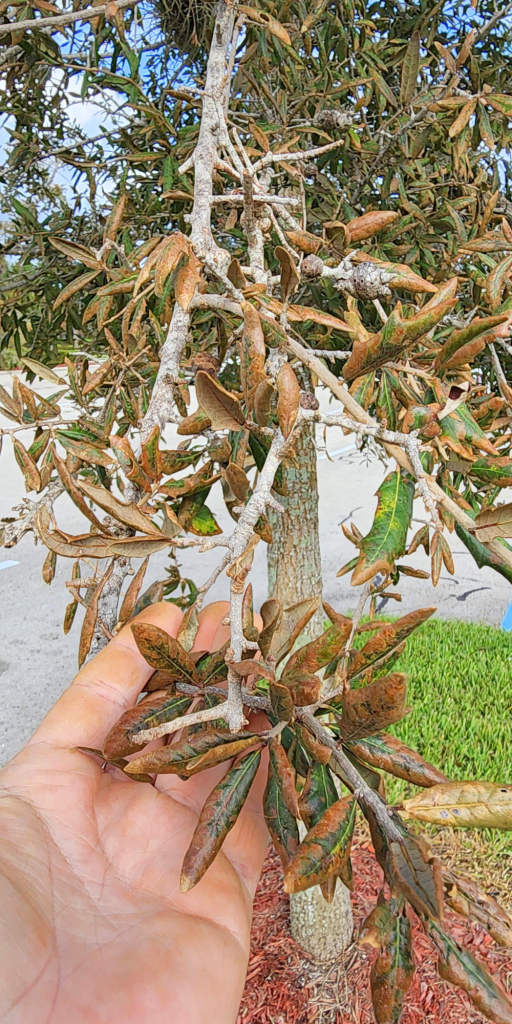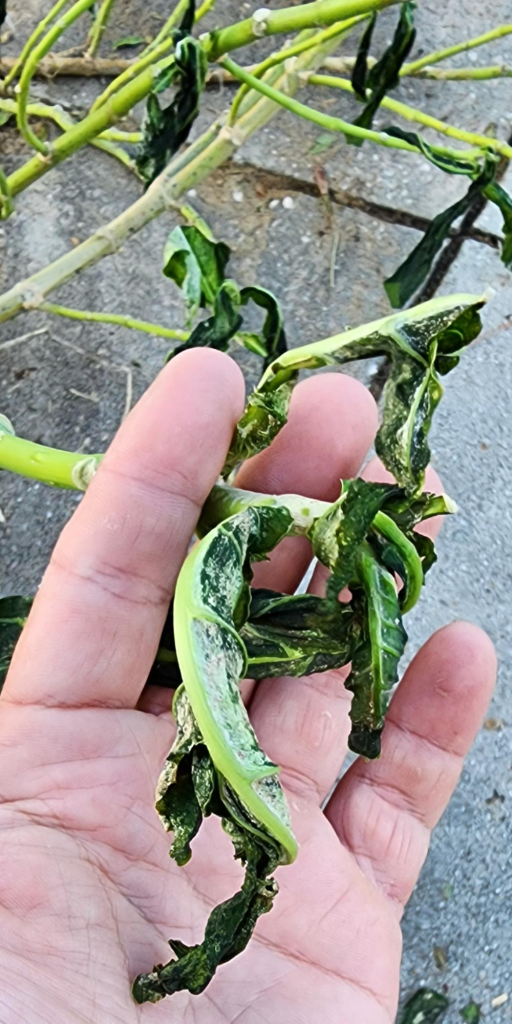One week after Hurricane Milton and on the final day of the rainy season, October 15th, I look out over our Educational Outreach Garden and see a landscape transformed. Lush and vibrant just a week ago for our Annual Plant Sale and Edfest, it now appears barren and brown, as if misted with herbicide. But this isn’t the onset of autumn—it’s the result of sodium chloride (NaCl), common table salt, carried inland by the hurricane’s desiccating winds.

On the south side of Hurricane Milton, we escaped the flooding rains that hit the Tampa Bay region, but the dry, hurricane-force winds carried something more damaging to our landscapes: undiluted sea spray. This combination of “wind burn” and “sea spray” damage has left Southwest Florida’s landscapes reeling. Let’s discuss these two common impacts and how to remedy them.
Wind Burn Damage
Wind burn on plants is very similar to what we experience as humans. On dry, windy days, you may feel your lips chap and skin dry as the moisture is pulled away by the rapidly moving air. Plants suffer the same fate as the wind desiccates their leaves. After Hurricane Milton’s prolonged winds, which interacted with a low humidity cold front, you might have noticed that browning of leaves. Starting at the edges and progressing inward toward the veins. This damage resulted from the wind’s desiccation of the plant’s moisture, leaving it looking scorched.
Fortunately, most plants can recover from wind burn, as it is a common side effect of cold fronts in Florida. However, the key to recovery is supplemental watering. With the end of our rainy season today and little rain in the ten-day forecast, it’s critical to water any plants you hope to rebound quickly. Many plants have depleted their water reserves, fighting off the storm’s drying winds. Replenishing that water will help them recover faster and promote new growth.
Read more about Wind Damage here: https://hort.ifas.ufl.edu/woody/wind.shtml
Sea Spray Damage
Accompanying the wind burn is another less obvious threat to our inland areas—sea spray. The morning after the storm, I found salt crystals covering my truck’s windows, like a light frost. This salty air, carried miles inland by the hurricane, coated the landscape. Usually, hurricanes bring enough rain to wash away the salt off the plants, but Milton was an exception. Without rain to dilute and rinse away the salt, the landscape has been bathed in a chemical that plants can’t tolerate.

Sodium chloride is deadly to most plants, and in this case, the leaves that remained intact were covered with salt. The first thing I did after shelter duty was rush home to spray down my most prized plants, like cacao and vanilla, with fresh water to remove the salt. If you weren’t able to do this immediately, there is still hope. The best advice I can offer now is to refrain from using chemical fertilizers. Fertilizers deliver nutrients in salt form, which could further inhibit the plant’s ability to absorb water. Instead, focus on giving your plants fresh water to help flush out the salt. This will give your plants the best chance at recovery.
Read more about Salt Damage here: https://hort.ifas.ufl.edu/woody/salt.shtml
Storm Surge: When Seawater Soaks the Roots
For those on the coast, storm surge brought another level of destruction. Hurricanes Helene and Milton both caused significant storm surges in coastal areas. Unfortunately, most plants impacted by saltwater flooding will not survive. Even native coastal plants like dune sunflower, which can handle sea spray, cannot tolerate being submerged in saltwater.
If any of your plants affected by storm surge show signs of life, you can try to irrigate them with fresh water to flush out the salt from the soil and give them the fresh water they sooo need. However, many plants will not recover from this type of damage. In these cases, it’s wise to research and invest in salt-tolerant plants that can withstand future storm surges. By planting smarter, you’ll build a more resilient coastal landscape.
Read more about Saltwater Flooding Damage here: https://edis.ifas.ufl.edu/publication/MG447
Conclusion: Patience and Fresh Water Are Key
In the days ahead, I expect the damage to our landscape to worsen before signs of recovery—like new leaf growth—begin to appear. Recovering from hurricane damage will take time, but patience and fresh water are the two biggest factors in helping your landscape plants bounce back. Even the toughest native plants might need a boost to recover after such an extreme natural disaster.
Avoid unnecessary pruning or cutting back, as it can add more stress to already weakened plants. Strategic pruning of broken or rubbing branches is fine, but wholesale trimming should pretty much be reserved for up-righting toppled trees.
As we look forward to rebuilding our landscapes, consider integrating more native and Florida-Friendly plants that are better suited to our climate and weather extremes. With care and time, our landscapes will be beautiful again soon. Let’s build back better, with plants that are not only attractive but resilient to the challenges our Florida environment brings.

During the preparation of this work, the author used ChatGPT to help build the blog post. After using this tool/service, the author reviewed and edited the content, and takes full responsibility for the content of the publication.
 11
11
